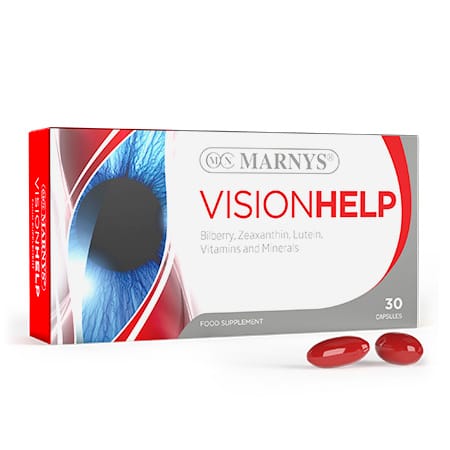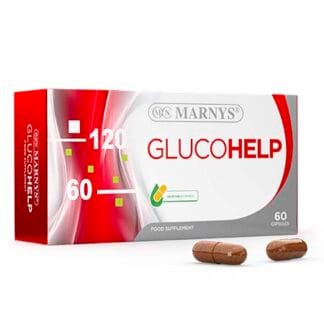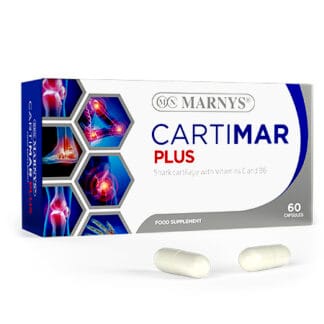Description
MARNYS® Visionhelp with its exclusive formulation and ingredients contributes to visual health. MARNYS® Visionhelp and its ingredients are an excellent supplement for people who want to contribute to their visual health, especially those who are under intense radiations, for example people working outdoors, with computers (blue light)...
Compared to other organs, the eye is very susceptible to oxidative damage due to continuous exposure to light and its high metabolic level.
The ingredients in MARNYS® Visionhelp facilitate vision care due to the following properties:
- Bilberry (Vaccinium myrtillus) is a widely spread shrub whose fruits are round, violet or purple berries with bluish tonality and contains high polyphenol concentrations, especially anthocyanins, which have shown antioxidant effect. The bilberry concentrate in MARNYS® Visionhelp provides 25% anthocyanosides. Bilberry helps maintain visual health through antioxidant effects and the maintenance of blood vessel integrity (EFSA ON HOLD 2001, 2002).
- Vitamin B2 (riboflavin) and the mineral Zinc contribute to normal maintenance of vision; besides, Zinc contributes to normal vitamin A metabolism (EFSA).
- Vitamins C and E, and the mineral Selenium, contribute to cellular protection from oxidative damage. Moreover, vitamin C contributes to normal formation of collagen for normal blood vessel function (EFSA).
- Taurine is an amino acid that can be obtained from dietary sources (like poultry, beef, pork or seafood), or produced by the body through the amino acids methionine and cysteine. It is produced in the liver and is highly concentrated in the retina.
- The carotenes Lutein and Zeaxanthin are yellow fat-soluble pigments concentrated in the macula, which is the central part of the retina and allows us to have sharp vision. Lutein can be found in various vegetables and grains, spinach, broccoli, corn, asparagus, wheat seeds, and in orange or yellow fruits, such as mango, papaya, oranges, melon, and so on. Zeaxanthin is found in certain vegetables and in certain yellow or orange fruits like corn, nectarines, oranges, watercress, or chicory, among others. Furthermore, high quantities of both Lutein and Zeaxanthin can be found in egg yolk.
- The minerals Calcium and Magnesium contribute to normal neurotransmission and electrolyte balance, respectively (EFSA).
- Vitamins B3 and B1 (nicotinamide and thiamine) contribute to normal energy-yielding metabolism (EFSA).
- L-Arginine is an amino acid that plays a role in some metabolic pathways, such as that of nitric oxide, which is involved in the structure and function of blood vessels. Dietary sources of arginine are fish, seafood, beef liver, peas, and lentils, among others.
- Chromium contributes to maintenance of blood glucose levels (EFSA).

VISION

ANTIOXIDANT

QUALITY PRODUCT
To Know More
How does the vision process work?
The vision process begins in the eye and continues with a series of complex chemical reactions that end in a nerve impulse that reaches the brain.
Our eyes are made up of two chambers:
- The first one consists of the lens, which focuses the objects, and the pupil, which is responsible for the light that reaches the bottom of the eye.
- The second one is the retina, which is located at the bottom of the eye and contains a vast number of photoreceptor cells specialised in capturing light: cones and rods. Cones contain the protein called rhodopsin (it has got vitamin A-retinal) and other pigments that are responsible for colour vision with bright light, and are very abundant in an area called ‘macula’ where the point of greatest visual acuity is located. Rods only have got rhodopsin and are responsible for vision under low light conditions.
When light arrives it changes the configuration of retinal, leading to a change in the electrolyte balance of the membrane and generating a nerve impulse. This nerve impulse reaches the brain where it is interpreted as an “image”.
What elements can affect our vision?
UV light from the sun, fluorescent light or ‘blue light’ from computer screens, mobile phones, televisions, exposure to pollutants and oxidants such as tobacco smoke, or an unbalanced diet, among others, are all factors that negatively influence eyesight. These factors contribute to the formation of free radicals, which are capable of oxidising the lipids in the cell membranes that capture light (photoreceptors) and of causing damage to the retina.
The lack of some vitamins, minerals and other components in the diet also affects our eyes, very sensitive to the food we eat. To maintain good eye health, diet plays a key role.
Different clinical studies have been conducted to know the benefit of antioxidants in ocular pathologies; one of the most significant, AREDS, with over 4,700 patients evaluated during at least 5 years, proved that the use of antioxidants reduced the risk of Macular Degeneration by more than 25%.
Currently, the American Academy of Ophthalmology guidelines recommend the use of antioxidants (including vitamins, minerals and carotenes) for the maintenance of visual function.
Referencias
- Academia Americana de Oftalmología, 2019. https://www.aao.org/
- Rasmussen, H. M. et al (2013). Nutrients for the aging eye. Clin Interv Aging.











Reviews
There are no reviews yet.